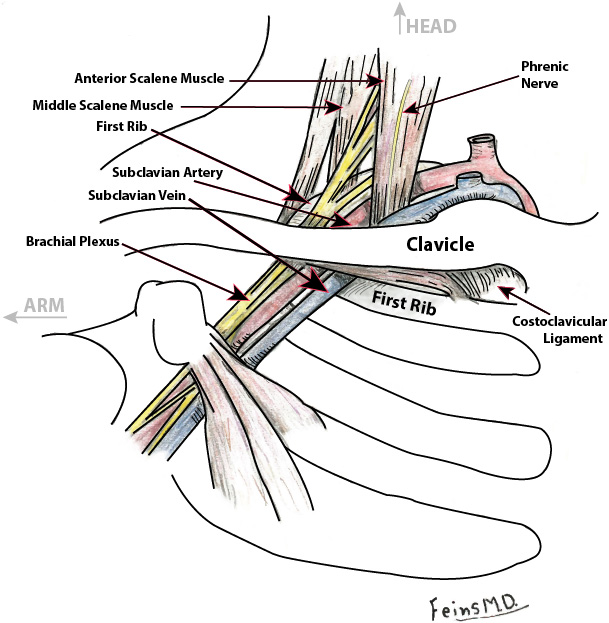TOS | Symptoms & Causes
What are the symptoms of thoracic outlet syndrome?
Symptoms of thoracic outlet syndrome include:
- neck pain
- shoulder pain
- arm pain
- numbness and tingling of the fingers
- impaired circulation to the extremities causing discoloration, swelling, or pain
How can I reduce the symptoms?
If you have TOS, you should avoid holding your arms out or overhead for long periods. Avoid sleeping with your affected arm extended behind your head. You should also avoid repetitive motions with your arms, including lifting heavy objects repeatedly. Take rest periods at work and throughout the day to minimize fatigue.
What causes thoracic outlet syndrome?
It is not always possible to know what caused thoracic outlet syndrome. Any condition that results in enlargement or movement of the muscle, bone, and other tissues near the thoracic outlet can cause thoracic outlet syndrome.
Causes may include:
- muscle enlargement, such as from weight lifting
- repetitive use, such as in baseball and rowing
- injury
- an extra rib
- weight gain
TOS | Diagnosis & Treatments
How is thoracic outlet syndrome diagnosed?
Proper diagnosis is the most important step in treating thoracic outlet syndrome. Your doctor will perform a complete physical exam and review the results of previous diagnostic tests.
Your doctor may recommend a thorough evaluation by a skilled neurologist to rule out cervical spine disease and other neurological conditions with similar symptoms.
Additional tests that help diagnose thoracic outlet syndrome include:
- nerve conduction studies to evaluate the function of the motor and sensory nerves
- vascular ultrasound studies of the arteries or veins
- chest x-ray to rule out cervical rib abnormalities
- computed tomography (CT) scan or magnetic resonance imaging (MRI) of the chest or spine
- magnetic resonance imaging with angiography (MRA) to view blood vessels
- ateriogram/venogram, an x-ray that uses dye to look at blood flow
How is thoracic outlet syndrome treated?
Most cases of neurogenic thoracic outlet syndrome can be treated with physical therapy and medication. Severe cases may require surgery.
Physical therapy
Physical therapy includes a variety of exercises that effectively stretch open the tissues of the thoracic outlet. These are done with and without weights to pull the outlet into a "relaxed" open position. Physical therapy may be done before surgery, as in the case of neurogenic TOS, or may be prescribed after surgery to help you regain strength and stability.
Medications
Your doctor might prescribe medications such as an anti-inflammatory medications (ibuprofen, Advil) or muscle relaxants to help relieve your symptoms. Cortisone injected into a joint or muscle can help lower inflammation and provide relief. If you have venous or arterial TOS, your doctor may prescribe blood thinners to prevent or treat blood clots.
Surgery
Although neurogenic TOS can often be treated with exercise and physical therapy, you may need surgery if your symptoms continue despite these treatments. The primary goal of surgery is to remove the source of compression on the nerves that supply the arm, forearm, and hand. This is typically accomplished by removing the first rib, anterior scalene muscle, and any additional abnormal muscles or fibrous bands. If there is an extra rib causing compression, it should also be removed.
Most patients with venous or arterial TOS will need surgical treatment. Surgery for venous and arterial TOS is very effective when performed before blood clots have a chance to form. If you have venous TOS and a blood clot has already formed, you will need emergency treatment to dissolve the clot and thin the blood. Surgery will reduce your risk of another clot or the return of symptoms.
How we care for thoracic outlet syndrome
Our goal in the Thoracic Outlet Syndrome Program at Boston Children’s Hospital is to return our patients to full function. This requires varying levels of intervention, depending on your particular circumstances, and ranges from physical therapy to interventional radiologic techniques to surgery, or often a combination of all three.



